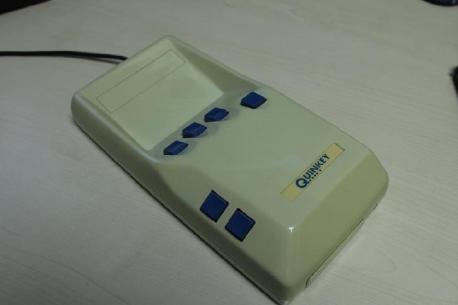A USB Quinkey chording keyboard
In about 1990, I recovered a Quinkey chording keyboard which was being thrown out by my school. For the unfamiliar, a chording keyboard is a text entry keyboard where there are fewer buttons than there are letters (typically only one button for each finger) and you press multiple buttons at once to type a character. Their proponents will tell you that they are much more ergonomic and faster to type on than the QWERTY keyboards we have become used to.

One of the early electronic chording keyboards was used in a Microwriter in the late 1970s to early 1980s. The MicroWriter was a standalone, battery powered chording keyboard with a few KB of built in memory and a small LCD display. You could use it to write documents while on the move and then attach it to a printer when you got to the office. You wrote on it using these combinations of keypresses:

A Quinkey is a cut-down Microwriter without the display or storage electronics inside it and was intended as a text input device for a BBC B microcomputer using the same chord patterns. It was possible to connect four Quinkeys up to a single BBC B and have multiple people operating the one computer, each with a quarter of the screen to themselves. It was marketed to schools as a way to get more kids using computers without needing to buy more computers, which probably explains why my school had one. Chording keyboards have a steep learning curve to get past before you can actually enter any text, and very few programs on the BBC Micro ever supported the Quinkey - which probably also explains why I had no idea they even existed until I found one in the bin.
Thanks to the awesome people at archive.org, you can read a review of the Quinkey from a 1984 issue of Acorn User. It’s a very technical review, and goes into incredible detail about the inner workings of the Quinkey and its bundled software.
I had a BBC Micro at home, but I didn’t have the interface box which connected a Quinkey to it - so it was fairly useless to me. But I didn’t want to throw it away, so I put it in a cupboard in my parents house and forgot about it for about 20 years, until I had a house of my own and my mother, quite understandably, wanted me to move all my junk out of hers.
So I then had a Quinkey which was taking up space in my house, and a desire to actually see what it was like to type on it. I also had a BBC B in the loft, but still not the interface box to join the two together, so the first idea was to re-build the interface and somehow acquire some software which could talk to it. After discovering that the interface attached 4 of them to the analogue port, I had a hunch that it was quite simple inside, and all the cleverness was happening in the software. A multimeter confirmed that it was a simple resistor ladder inside the Quinkey to generate an analogue voltage which the BBC must then have sampled.
And from that, a plan was formed - I would do the same sampling using an ADC on a microcontroller and turn it into a USB HID keyboard. I could then use it on my everyday computer, learn how to type on it and see if chording keyboards are worth the learning curve.
There was a Hacksoton event in 2014, where people build things on the day and then do a show and tell at the end, and I didn’t have any other projects that needed doing. With some cutting of corners, it was possible to solder up some interfacing hardware, write some Arduino code and memorise enough of the chords to type on it during the 6 or so hours that the event ran. The longest part of the process was manually translating the chording patterns into a binary representation for the Arduino and mapping those to an ASCII character.
I was able to take my laptop up on stage at the end of the day with the Quinkey and the hastily constructed electronics on a prototyping board and give an explanation of what I’d been doing all day, and use the Quinkey to type the word “hacksoton” into a text editor on my laptop.
No recordings exist of that, but I’ve put a short video together to demonstrate how to type on it.
Was it worth it? Are chording keyboards useful?
I think they are a neat idea and I’m happy that I’ve made this work, but chording keyboards for mobile use are clearly from a pre-touchscreen world. The use-case of a Microwriter where a businessman writes his memos on on it during his morning train ride into the office and then connects it to a printer when he gets there has been completely obsoleted by smartphones and laptops. I’m glad I’ve got a Quinkey, but I view it more as a historical artifact than a useful piece of tech.